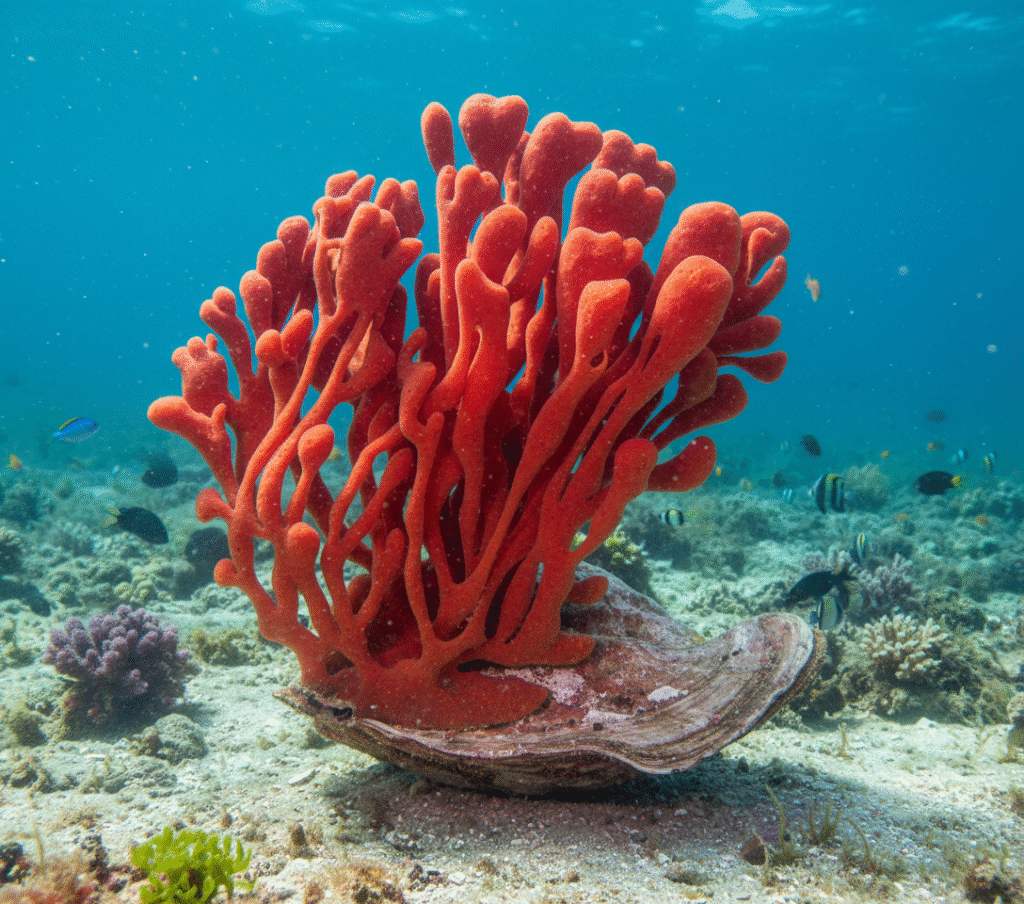Classification of Microciona
- Phylum: Porifera (Pore-bearing animals with cellular organization and asymmetrical or radial symmetry)
- Class: Demospongiae (Sponges with skeletons made of spongin fibers and siliceous spicules)
- Order: Poecilosclerida (Sponges characterized by diverse spicule types and typically specialized skeletons)
- Family: Microcionidae (Sponges with a skeleton primarily of acanthostyles and other specialized spicules)
- Genus: Microciona
Microciona is a genus of marine sponges known for its bright coloration and encrusting to branching growth forms. Members of this genus are important contributors to benthic marine ecosystems, often found covering rocks, shells, and other hard substrates.

Habit and Habitat
Microciona species are typically found encrusting or forming thin sheets or small branching masses on submerged rocks, bivalve shells, and marine debris. They thrive in both sheltered and exposed marine environments, from intertidal zones down to depths of about 180 meters. These sponges prefer locations with stable substrates and active water flow, facilitating filtration feeding.
Geographical Distribution
Microciona is distributed widely across the North Atlantic, with notable populations from the White Sea to the Mediterranean, including the coasts of Ireland, southern and western Britain, and the Channel Islands. Some species are also found in tropical and subtropical marine regions worldwide.
General Characteristics
- In deep-sea water the colony becomes massive and develops upto 10 cm in total length.
- It is bright red coloured. Sponge comprises of several finger like projections in ascending order.
- It has large spicules united by spongin into a regular network.
- It is largely used to study regeneration and reassociation experiments.
- Dissociated cells from same species reaggregate.
- Humphrey has shown that in this animal calcium and magnesium ions along with some cells surface are necessary for aggregation.
- The body ranges from thin encrusting sheets to thicker, brittle crusts up to 1-5 mm thick.
- Coloration includes bright reds, oranges, and sometimes brown hues when dried.
- The sponge surface is smooth to finely hispid, with transparent oscula featuring converging excurrent channels.
- The skeleton is made up of ascending plumose bundles of large acanthostyles echinated by smaller acanthostyles; surface layers contain subtylostyles.
- Microscleres such as palmate isochelae and toxas are also present and frequent throughout the skeleton.
- The sponge lacks contraction ability and is generally brittle in thicker specimens.

Special Features
A distinguishing feature of Microciona sponges is the extreme variation in spicule size, especially the large, recurved spines on smaller acanthostyles. This morphological trait is characteristic and aids in species identification. Additionally, Microciona provides important microhabitats for numerous marine invertebrates.
Identification
Identification of Microciona requires careful microscopic examination of spicules, particularly the unique combination and size variation in acanthostyles and microscleres. Field identification is aided by bright coloration and the texture of the sponge crust, which can be brittle in thicker regions.
References:
- https://www.habitas.org.uk/marinelife/sponge_guide/sponges.asp?item=C8110
- https://en.wikipedia.org/wiki/Clathria_aceratoobtusa
- http://www.marinespecies.org/aphia.php?p=taxdetails&id=157404
- https://www.cambridge.org/core/journals/journal-of-the-marine-biological-association-of-the-united-kingdom/article/new-species-of-clathria-microciona-poecilosclerida-microcionina-microcionidae-from-the-tropical-southwestern-atlantic-ocean-sergipe-state-northeastern-brazil/543EB598C96EC184C683BEB4B87FCAE5
- https://en.wikipedia.org/wiki/Clathria_prolifera
- https://www.habitas.org.uk/marinelife/sponge_guide/sponges.asp?item=C8130
- http://www.marinespecies.org/porifera/porifera.php?p=taxdetails&id=157404
